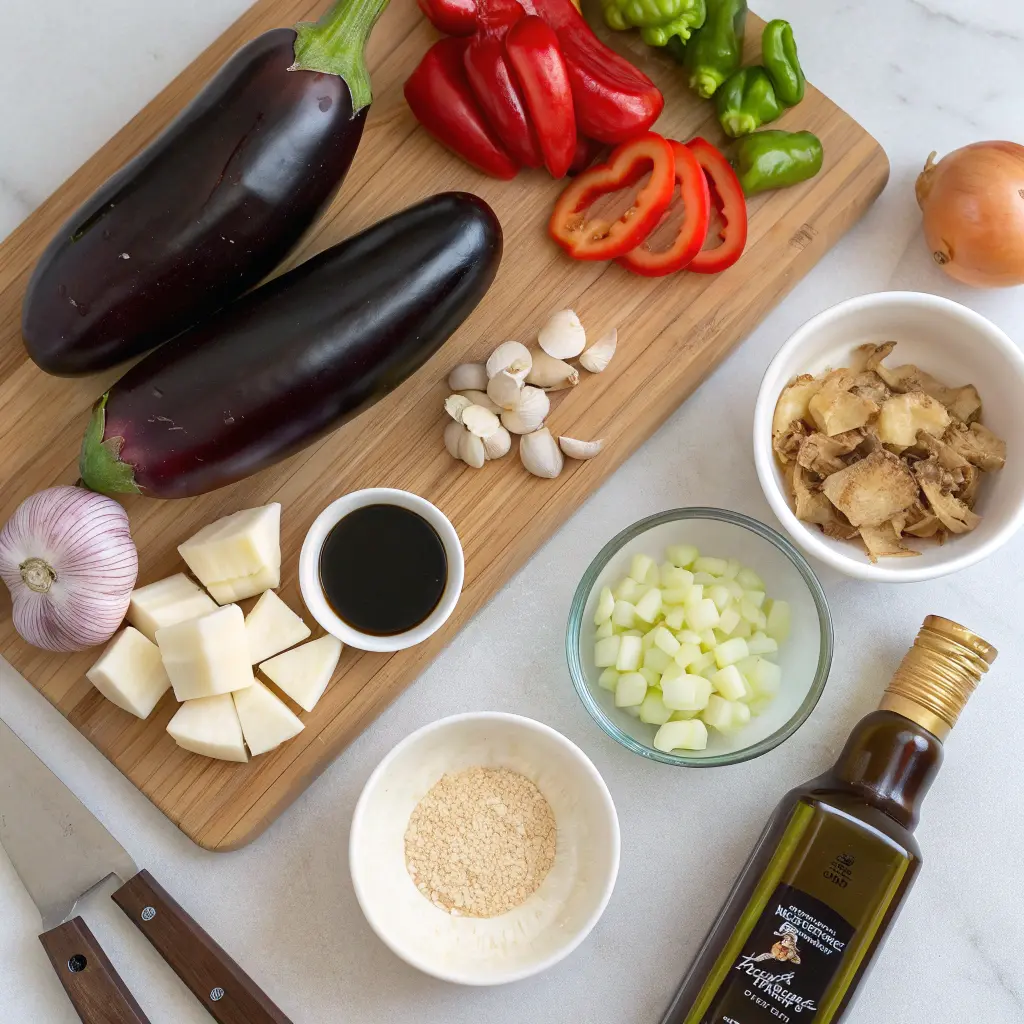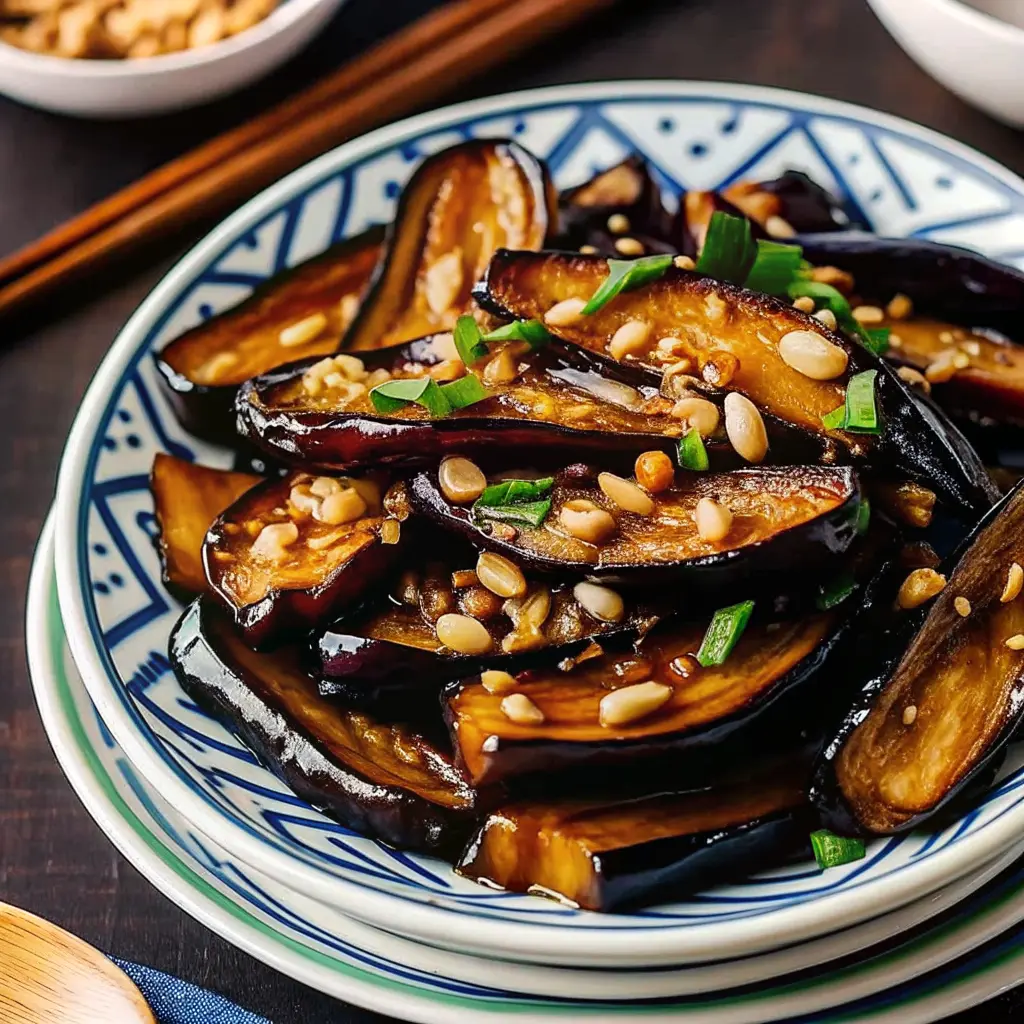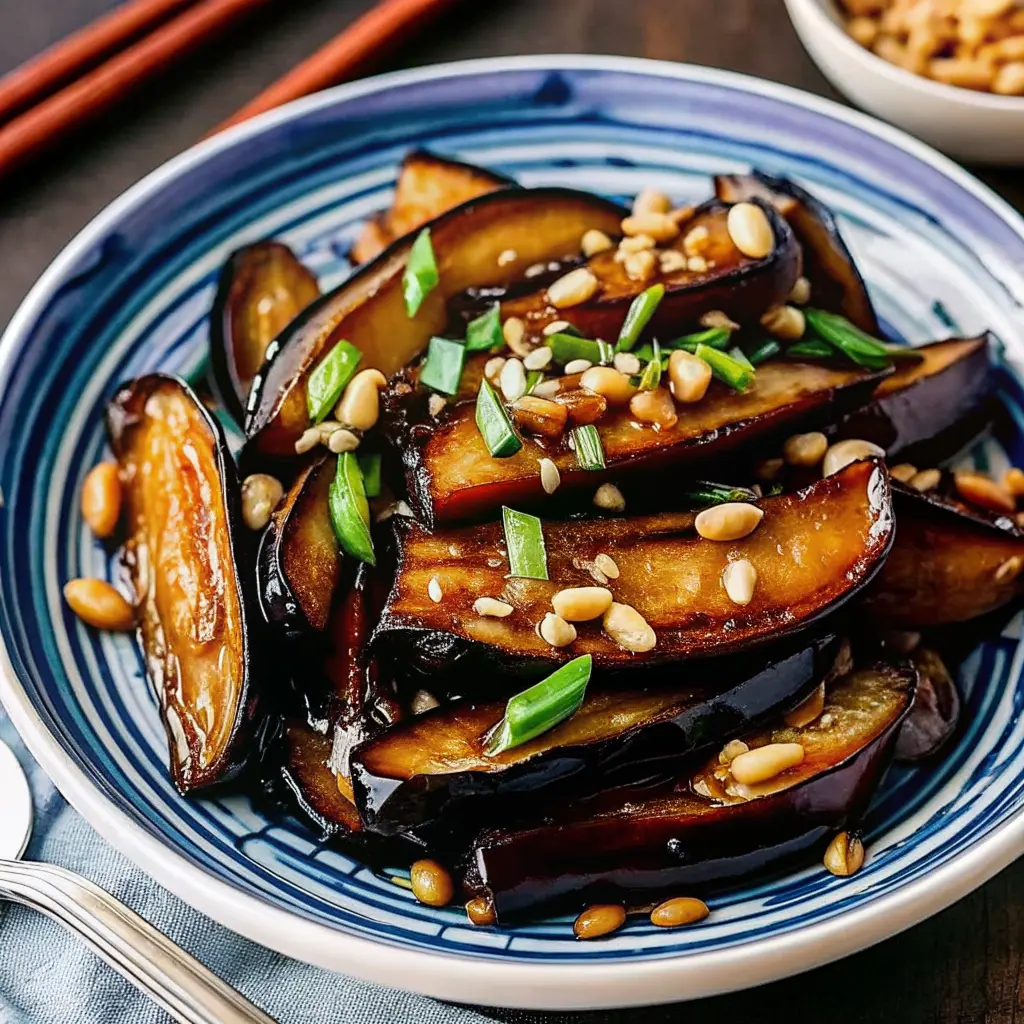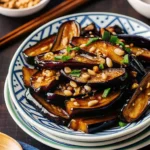Eggplant with Garlic Sauce Stir Fry: A Complete Guide
Introduction
Eggplant with Garlic Sauce Stir Fry offers that irresistible restaurant-style tangy-garlicky sauce with tender, silky eggplant glazed in a shimmering sauce. This dish brings rich flavor and texture, plus a quick, one-pan cooking experience that’s perfect for busy weeknights or taking your dinner game to a new level. Follow along, and by the end you’ll be ready to deliver that perfect stir-fry dish that tastes like it came straight out of your favorite Chinese restaurant.
What Is Eggplant with Garlic Sauce Stir Fry?
This classic is a beloved Chinese dish that features soft, succulent eggplant enveloped in a savory, slightly sweet garlic sauce. Though it shares similarities with the yu-xiang (fish-fragrant) eggplant variant, the garlic sauce version tends to be milder and more direct in its flavor profile—while still deliciously satisfying.
To dive deeper into the origins of flavor enhancers like Shaoxing wine and add nuance to your cooking, check out what Shaoxing wine is, a helpful resource that explains the background of this classic Chinese cooking wine.
Origins & What Makes This Dish Shine
This dish has roots in Chinese restaurant favorites—a sort of hybrid between Cantonese takeout styles and regional versions infused with Sichuan-style depth. Some interpretations keep things mild and glossy, while others introduce a spicy, savory edge with ingredients like doubanjiang.
If you’re curious about the bold fermented bean paste that can turn up the umami and heat, you’ll want to learn about doubanjiang, an article that demystifies this flavorful ingredient and how it transforms dishes.
Choosing the Right Eggplant
Not all eggplant types are created equal in stir-fry. Here’s how to pick the best one:
- Asian (Chinese/Japanese) eggplant — long, thin, with fewer seeds and tender skin. Cuts faster, absorbs optimal sauce, and stays creamy.
- Globe (Western) eggplant — more bulbous, thicker skin, more seeds. Perfectly usable, but slice smaller and adjust cook time accordingly.
When using globe eggplant, here’s how to adapt:
- Slice into small, manageable wedges or cubes.
- Rinse and pat dry thoroughly after salting or soaking.
- Stir-fry in smaller batches to ensure each piece gets enough heat and gloss.
Building the Garlic Sauce
Creating the sauce is central to this recipe’s magic. Key components:
- Light soy sauce — fundamental savory base
- Dark soy sauce — for depth and rich color
- Sugar — a subtle sweetness to balance savory and tang
- Rice vinegar — brightness and lift
- Shaoxing wine (optional) — aroma and depth
- Cornstarch slurry (cornstarch + water) — gives that glossy, clingy coat
Each ingredient plays a role:
- Light soy adds the base saltiness.
- Dark soy enhances color and umami dimension.
- Sugar softens and balances the savory notes.
- Vinegar cuts richness with a tangy contrast.
- Shaoxing wine elevates the aroma.
- Cornstarch slurry seals everything in a lustrous glaze.
Essential Equipment & Heat Management
To master this dish, the right tools—and how you use them—matter:
- Carbon-steel wok (preferred) — offers swift heating, precise high-heat control, and that seared flavor.
- Wide skillet — works well if you don’t have a wok—just ensure it’s hot enough and spacious.
- Neutral oil (e.g., grapeseed, peanut, refined vegetable) — key for withstanding high temperatures without overwhelming the flavors.
Pro tip: Always pre-heat the wok until it’s smoking slightly, then add oil. That quick burst of heat is what gives the eggplant crisp edges without becoming greasy.
Preparing the Eggplant: Cutting, Salting, and Pre-Cooking Options
Eggplant is like a sponge—it soaks up oil if not prepared—so proper prep is vital:
Two effective methods to prevent oil-absorption:
- Salt + Rinse + Dry
- Coat cut pieces with salt, let rest 10–15 minutes.
- Rinse off the salt, then thoroughly pat dry.
- Cold Salt-Water Soak
- Soak eggplant in lightly salted cold water for 10 minutes.
- Drain and pat dry completely.
Optional coatings: Lightly dust with cornstarch before frying for a crisp, lightly battered edge.
Alternate pre-cooking methods to tailor texture and oil usage:
- Pan-sear batches — golden edges, less oil absorbed.
- Shallow-fry — more crunch, richer texture.
- Steam or microwave — oil-free, incredibly tender, but soft.
- Air-fry or oven-roast — healthier, crisp, and efficient; finish in the wok for sauce glue.

Aromatics & Spice Add-Ins
These components are the aromatic backbone:
- Garlic — the star; finely minced or grated.
- Ginger (optional) — adds sharp depth.
- Scallion (green part) — fresh brightness to finish.
- Dried red chiles / Sichuan peppercorns (optional) — for a spicy-tingly accent.
Timing matters:
- After removing seared eggplant, add aromatics to the hot pan, letting them bloom briefly—this infuses the oil and awakens their aroma.
- If using chiles or peppercorns, toss them in with aromatics for a flavor lift that’s more complex.
Mise en Place: Organization for Stir-Fry Success
Preparation sets you up for smooth cooking. Have these ready before heating the pan:
- All aromatics chopped: garlic, ginger, scallion, chiles if using.
- Sauce pre-mixed: soy sauces, vinegar, sugar, Shaoxing, cornstarch slurry.
- Eggplant dry and ready: coated or not, depending on method.
- Wok or skillet pre-heated and smoking ready: ensures fast, even cooking.
Good mise en place is the secret to tight timing and sizzling outcomes.
Cooking Process: Step-by-Step Method (High-Heat Stir-Fry Timeline)
Here’s the core technique for a knockout result:
- Heat the wok until it’s nearly smoking, then add oil and swirl.
- Add eggplant (in batches). Let it sit a moment before stirring—this gives golden, seared texture. Cook until edges are slightly brown and the centers are just tender. Remove and set aside.
- Toss in aromatics (garlic, ginger, optional chiles). Stir-fry for 10–20 seconds until fragrant—don’t let them burn.
- Return eggplant to the wok quickly. Stir to combine.
- Add the pre-mixed sauce, stirring rapidly so it thickens and coats each piece with that beautiful sheen.
- Finish with scallions, toss once, then transfer immediately to serving dish.
Visual cues to watch:
- Eggplant should look lightly browned with gently collapsing flesh.
- Sauce should go from thin to a sticky, lacquer-like glaze in 30–60 seconds.
- You want the garlic aroma but not charred or bitter notes.
Variations: Customize to Your Mood
Mix things up based on what you’d like to highlight:
- Ground Pork Eggplant Stir-Fry
- Brown pork first, break into crumbles, then follow the usual eggplant path.
- Tofu & Eggplant
- Press and cube tofu; pan-fry until golden. Add for texture contrast.
- Green Beans + Eggplant Fusion
- Blister green beans first, then add eggplant for a veggie twist with snap.
- Sichuan-Style Spicy Version
- Incorporate doubanjiang and Sichuan peppercorns for numbing spice and umami.

Adjusting Flavors: Tailor Sweet, Tang, or Spice
You’re in control—adjust to suit your taste:
- Sweetness → add more sugar.
- Tang → increase rice vinegar.
- Umami/Depth → boost dark soy or add doubanjiang.
- Alcoholic aroma → add more Shaoxing wine (or dry sherry if needed).
- Spice → ramp up chiles or Sichuan peppercorns.
Tweak before adding sauce slurry or at the end splash; it’s all about hitting that balance.
Serving Suggestions & Pairings
This stir-fry pairs beautifully with:
- A bed of steaming jasmine rice to soak up the sauce.
- Chow mein or lo mein noodles tossed lightly in oil for flavor economy.
- Simple side greens, like stir-fried bok choy or blanched broccoli, for color contrast.
- Garnish ideas: toasted sesame seeds, slivered scallions, or a spritz of vinegar.
Those glossy eggplant pieces shine best when balanced with plain, cooling sides.
Make-Ahead, Storage & Reheating
Planning ahead? Here’s how:
- Best enjoyed immediately, when the sauce is freshest and texture is optimal.
- After cooling to room temp, store in a sealed container in the fridge for 3–4 days.
- When reheating, add a splash of water or soy and gently re-warm on high to revive that glossy coating.
- Freezing isn’t recommended—eggplant tends to turn mushy when frozen and thawed.
Troubleshooting Common Issues
| Problem | Fix/Solution |
|---|---|
| Eggplant is too greasy | Dry thoroughly; use high heat and batch cook |
| Sauce stays watery | Increase cornstarch or let it reduce longer |
| Sauce too dark/salty | Cut back dark soy; add sugar or vinegar to rebalance |
| Aromatics are bitter | Cook quickly over medium-high heat; don’t burn |

FAQs (Quick Answers)
- Do I have to salt or soak eggplant first?
Salting or soaking helps reduce oil absorption and yields more tender texture. - Can I use regular globe eggplant?
Yes—slice it smaller and adjust cooking time to accommodate its thicker flesh. - What’s in Chinese garlic sauce?
A mix of soy sauces, sugar, vinegar, cornstarch slurry, with optional Shaoxing wine or doubanjiang for complexity. - How do I keep eggplant from becoming mushy?
Dry it well, cook on high heat, don’t overcrowd the pan, and stir-fry quickly. - Is this dish naturally vegan?
Yes—it’s plant-based unless you add meat or animal products on purpose. - Can I air-fry or roast the eggplant first?
Absolutely—then finish it in the wok with the sauce for that classic glossy finish.
Conclusion
Eggplant with Garlic Sauce Stir Fry is more than just a quick dinner—it’s a showcase of silky eggplant, aromatic garlic, and a rich, glossy sauce that’s balanced in flavor and visually irresistible. With the right preparation techniques, high-heat stir-fry method, and careful flavor adjustments, you can recreate a dish that rivals your favorite takeout—right in your own kitchen. Whether you keep it simple, go bold with Sichuan spices, or add proteins and extra veggies, this recipe is endlessly adaptable. Serve it hot, share it generously, and enjoy every savory, garlicky bite.
Print
Irresistible Eggplant with Garlic Sauce Stir Fry – Silky, Flavor-Packed Chinese-Style Recipe
- Total Time: PT22M
- Yield: 4 servings 1x
- Diet: Vegetarian
Description
This Eggplant with Garlic Sauce Stir Fry is a savory and aromatic dish featuring tender eggplant coated in a glossy garlic sauce. Perfect with steamed rice or noodles, it’s a flavorful, quick-to-make dinner that’s both comforting and satisfying.
Ingredients
- 2 medium eggplants (about 1 lb), cut into bite-sized wedges
- 3 tbsp vegetable oil (divided)
- 4 cloves garlic, minced
- 1-inch piece fresh ginger, minced
- 2 green onions, chopped (white and green parts separated)
- 1 red bell pepper, sliced (optional)
For the Sauce:
- 3 tbsp soy sauce
- 1 tbsp dark soy sauce (for deeper color)
- 1 tbsp rice vinegar
- 1 tbsp hoisin sauce
- 1 tsp sugar
- ½ cup vegetable broth or water
- 1 tsp cornstarch mixed with 2 tsp water
Instructions
- Prepare the eggplant
- Sprinkle cut eggplant pieces with a little salt and let them sit for 10 minutes to draw out moisture. Pat dry with paper towels.
- Stir fry the eggplant
- Heat 2 tbsp oil in a large skillet or wok over medium-high heat. Add eggplant and cook for 5–7 minutes, stirring occasionally, until softened and lightly browned. Remove and set aside.
- Make the sauce
- In a small bowl, whisk together soy sauce, dark soy sauce, rice vinegar, hoisin sauce, sugar, and vegetable broth.
- Sauté aromatics
- In the same skillet, add the remaining 1 tbsp oil. Add garlic, ginger, and the white parts of green onions. Sauté for 30 seconds until fragrant.
- Combine and thicken
- Return eggplant (and red bell pepper, if using) to the pan. Pour in sauce and stir to coat. Add cornstarch slurry and cook 1–2 minutes until the sauce thickens.
- Finish and serve
- Stir in the green onion tops, adjust seasoning if needed, and serve hot with steamed rice.
- Prep Time: PT10M
- Cook Time: PT12M
- Category: Main Dish
- Method: Stir Fry
- Cuisine: Chinese
Nutrition
- Calories: 180kcal
- Sugar: 5g
- Sodium: 850mg
- Fat: 10g
- Saturated Fat: 1.5g
- Unsaturated Fat: 8g
- Trans Fat: 0g
- Carbohydrates: 20g
- Fiber: 5g
- Protein: 4g
- Cholesterol: 0mg


1 thought on “Irresistible Eggplant with Garlic Sauce Stir Fry – Silky, Flavor-Packed Chinese-Style Recipe”